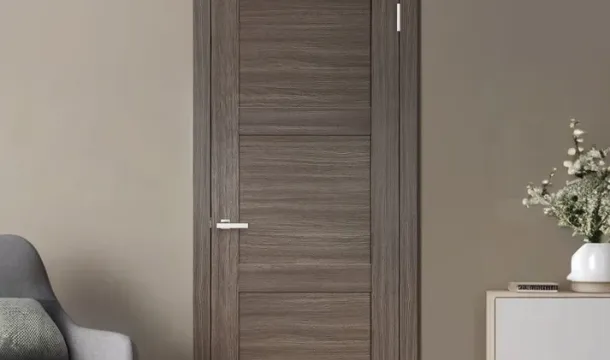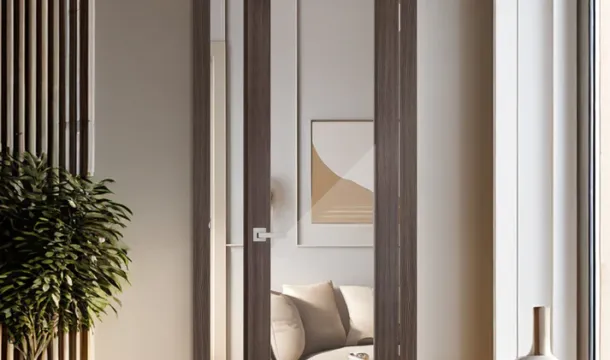Interior MDF Doors: Advantages and Features
Popular Articles
MDF (Medium Density Fiberboard) doors are becoming an increasingly popular choice for interior spaces, and for good reasons. They are made from wood fibers that have been compressed together, forming a smooth, durable, and uniform material. MDF doors are often chosen for their versatility, affordability, and ability to hold a painted finish without flaws. In this guide, we will take a closer look at MDF doors, their benefits, and why they are an excellent choice for many homeowners.
What Are MDF Doors?
MDF, or Medium Density Fiberboard, is an engineered wood product made by breaking down hardwood or softwood residuals into wood fibers, which are then combined with wax and resin and pressed into panels. The resulting material is dense, smooth, and ideal for crafting interior doors. MDF doors are typically used in homes that require a painted finish, as they have no visible grain and provide a flawless surface.
Advantages of MDF Interior Doors
1. Smooth Finish Ideal for Painting
One of the biggest advantages of MDF doors is their ability to take paint well. Unlike natural wood, which has a visible grain that can affect the appearance of a painted surface, MDF provides a perfectly smooth, consistent surface. This makes MDF doors the top choice for homeowners who want to paint their doors in a specific color that matches the décor of their home.
MDF doors can be easily primed and painted, allowing for virtually endless customization options. Whether you prefer a classic white or a bold, vibrant color, MDF doors provide an excellent canvas for your creative ideas.
2. Affordability
Compared to solid wood doors, MDF doors are much more affordable. This makes them an attractive option for budget-conscious homeowners who still want a high-quality, stylish door. While they are less expensive, MDF doors do not sacrifice appearance, as they can mimic the look of traditional solid wood doors once painted.
The cost-effectiveness of MDF also means that you can allocate your budget to other aspects of your interior design while still achieving an elegant, cohesive look throughout your home.
3. Resistance to Warping and Cracking
Natural wood doors can warp, expand, or contract due to changes in humidity and temperature, which can lead to issues like misalignment or difficulty in closing. MDF doors, on the other hand, are much more stable when exposed to varying environmental conditions. The engineered nature of MDF makes it resistant to warping, cracking, or splitting, providing long-term reliability.
This stability makes MDF doors especially suitable for interior spaces where consistent temperature and humidity levels may not be guaranteed, such as basements or laundry rooms.
4. Customization Options
MDF doors are available in a wide range of styles, including paneled, flush, and even custom designs. They can be routed and shaped to create intricate details, which makes them suitable for both traditional and modern interiors. Homeowners can select from different panel configurations and design elements, allowing for personalization that fits their specific tastes and home styles.
Whether you are looking for a classic paneled door or a modern minimalist design, MDF doors can be crafted to meet your preferences. The versatility of MDF means it is easy to achieve the desired look without the limitations that come with natural wood grain.
5. Ease of Installation
Another benefit of MDF doors is that they are relatively easy to install. Their uniform density and consistent weight make them easier to work with compared to some solid wood doors, which can be heavy and cumbersome. This ease of installation can save time and labor costs, making MDF doors a practical choice for many home improvement projects.
Considerations When Choosing MDF Doors
While MDF doors offer numerous benefits, there are some considerations to keep in mind. MDF is susceptible to moisture damage, which means that it may not be the best choice for areas like bathrooms or other high-humidity environments unless properly sealed. Water can cause the fibers in MDF to swell, leading to damage over time. However, with proper sealing and maintenance, MDF doors can still be used in these areas effectively.
Additionally, MDF doors are not as durable as solid wood when it comes to resisting impact. They can dent or scratch more easily compared to hardwood doors, so care must be taken to prevent damage, especially in high-traffic areas or homes with children or pets.
Comparing MDF to Other Door Materials
MDF doors have several advantages over other door materials, such as hollow core, solid wood, and veneer doors. Compared to hollow core doors, MDF provides a more solid feel and better sound insulation, which can improve privacy within the home. While they may not match the luxurious feel of solid wood doors, MDF doors offer a more cost-effective solution with a similar appearance when painted.
In comparison to veneer doors, MDF has the advantage of providing a smoother finish for painting and is less prone to peeling or bubbling. Veneer doors, which are typically made of a thin layer of wood over a core, can sometimes have issues with the veneer separating from the core over time, whereas MDF maintains its integrity without such concerns.
MDF interior doors are an excellent choice for homeowners looking for a cost-effective, customizable, and stylish solution. Their smooth surface makes them ideal for painting, allowing for a wide range of design possibilities to match any interior décor. With resistance to warping and ease of installation, MDF doors provide a practical and reliable option for many areas of the home.
While they may require some care to avoid moisture damage and scratches, the benefits of MDF doors far outweigh these considerations for most interior applications. By choosing MDF doors, you can achieve a beautiful, cohesive look throughout your home without exceeding your budget, making them a smart and versatile choice for interior design.
Popular Articles

Soundproofing Interior Doors: Which Options Are Best for Your Home?

Choosing the Perfect Interior Doors for Your Canadian Home
